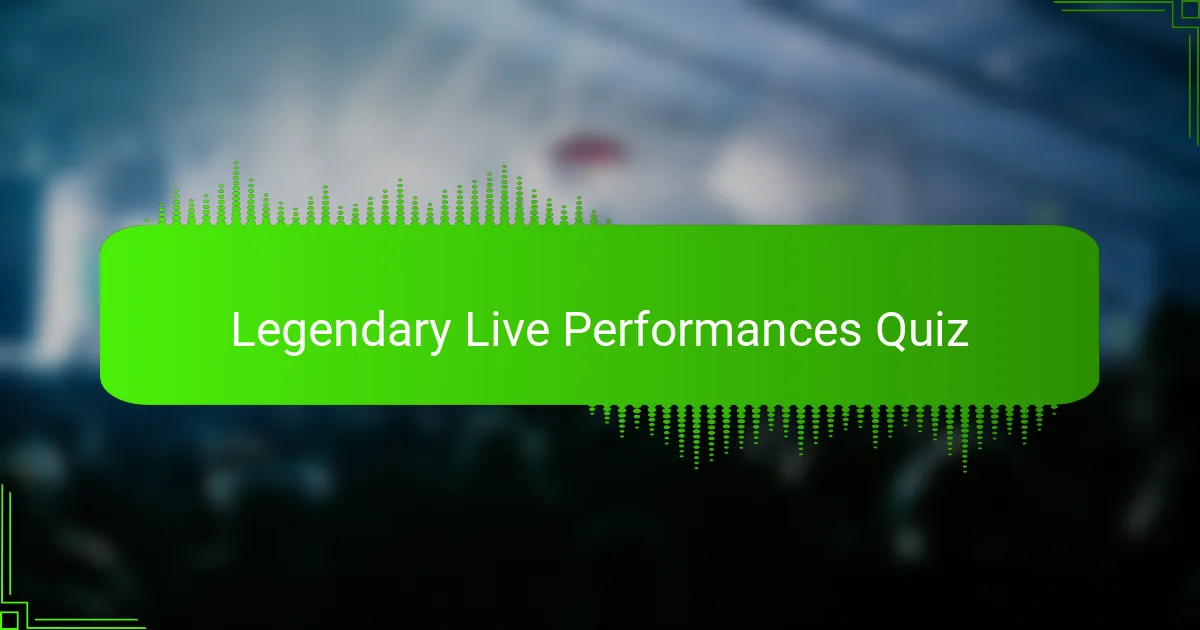
Congratulations on Completing the Quiz!
Well done! You’ve navigated through our quiz on Legendary Live Performances. We hope you found the experience enjoyable and enlightening. Live performances have shaped music history, and your engagement with these moments is vital to appreciating their impact.
Throughout the quiz, you likely discovered fascinating facts about iconic shows and the artists behind them. From the electrifying energy of stadium concerts to intimate club performances, each experience leaves a lasting imprint on both the musicians and their audiences. Understanding these events deepens our connection to music and the stories it tells.
Now that you’ve completed the quiz, we invite you to dive deeper into the world of Legendary Live Performances. Check out the next section on our page, where you will find a treasure trove of information about unforgettable gigs, legendary artists, and the historical significance of these performances. Your musical journey is just beginning!

Legendary Live Performances
Defining Legendary Live Performances in Music History
Legendary live performances refer to iconic concerts that have left a lasting impact on music culture and history. They often showcase exceptional artistry and memorable moments, captivating audiences worldwide. Historic examples include Jimi Hendrix’s performance at Woodstock in 1969, where his rendition of “The Star-Spangled Banner” became a symbol of the counterculture movement. These events are not only remembered for the music but also for the unique atmosphere and energy that define them.
The Role of Iconic Venues in Legendary Performances
Iconic venues contribute significantly to the experience of legendary live performances. Places like Madison Square Garden in New York and The Royal Albert Hall in London have hosted many unforgettable concerts. For instance, Queen’s 1975 performance at the Hammersmith Odeon in London showcased Freddie Mercury’s dynamic stage presence, establishing the venue as a hallmark of rock history. The setting amplifies the event’s emotional resonance, making it memorable for fans.
Notable Musicians Behind Legendary Live Performances
Numerous musicians have delivered legendary live performances that have shaped the music landscape. Artists like Bruce Springsteen, known for his marathon concerts, and Nina Simone, whose emotive performances of “Feeling Good” resonate deeply with audiences, are prime examples. Each artist brings a unique flair and connection with their audience, creating pivotal moments in music history that continue to inspire future generations.
Impact of Technology on Live Music Performances
Technology has transformed the nature of live music performances, enhancing both the production and audience experience. Innovations in sound engineering and lighting, as seen in U2’s 360° Tour, have set new standards for how concerts are staged. Video projections and high-definition displays create an immersive environment, contributing to the legendary status of these performances by engaging audiences in unprecedented ways.
Analyzing the Cultural Significance of Legendary Live Performances
Legendary live performances often reflect broader cultural movements and social issues. For instance, Bob Dylan’s 1965 performance at the Newport Folk Festival marked his transition to electric music, influencing the folk genre and highlighting the era’s cultural shifts. These concerts often serve as milestones, capturing the zeitgeist and resonating with audiences on deeper emotional and political levels.
What are some legendary live performances in music history?
Some legendary live performances include Jimi Hendrix at Woodstock in 1969, where he famously performed the national anthem. Another iconic moment was Queen’s performance at Live Aid in 1985, which is often cited as one of the greatest rock performances ever. Additionally, Nirvana’s MTV Unplugged session in 1993 showcased a different side of the band, leaving a lasting impact on audiences.
How did Michael Jackson’s performance during the Motown 25 special influence live performances?
Michael Jackson’s performance on Motown 25: Yesterday, Today, Forever in 1983 introduced the world to the “Moonwalk.” This moment significantly influenced live performances by showcasing the blend of music and dance, pushing other artists to elevate their stage presence. The performance is widely recognized for its innovative choreography and has since set a standard for future pop performances.
Where can fans watch legendary live performances today?
Fans can watch legendary live performances on various platforms, including YouTube, where many historic concerts are uploaded. Streaming services like Netflix and Amazon Prime occasionally feature music documentaries that highlight these performances. Additionally, dedicated music channels and platforms like Vevo host a collection of iconic live concerts, providing fans easy access.
When did the famous Woodstock festival take place, and why is it important?
The Woodstock festival took place from August 15 to August 18, 1969. It is crucial in music history as it represented the peak of the counterculture movement and featured legendary performances by artists such as Jimi Hendrix and Janis Joplin. Its significance lies in its embodiment of peace, love, and music, making it a cultural landmark.
Who are some artists known for their legendary live performances?
Artists known for legendary live performances include Bruce Springsteen, often referred to for his energetic shows. Tina Turner is lauded for her powerful stage presence, especially during her tours in the 1980s. Additionally, performers like Prince and David Bowie are celebrated for their theatrical and engaging concerts, leaving lasting impressions on audiences.

